
Happy March 20th! Do something to make somebody smile today. Don't just think about it........do it. Then think about it.............and how you just made somebody's world a tiny bit greener.
Our local chess tournament last Saturday got some great coverage. I'm extraordinarily proud of the kids and also the adults that helped run this event:
Scroll down and enjoy the latest comprehensive weather to the max. Here's the latest weather..... occurring because of the natural physical laws in our atmosphere. Tranquil weather this week! Then turning wet, especially the southern half.
Here are the latest hazards across the country.
Purple/Pink/blue on land is cold/Winter weather. Brown is wind, Green is flooding. Gray is fog. Reddish is a red flag advisory.
Go to the link below, then hit the location/county on the map for details.
https://www.spc.noaa.gov/ Go to "hazards"

Wind map Hit this with your cursor:


Wind map Press down on this on the left with your cursor!


Current Jet Stream

Winter Weather
https://www.wpc.ncep.noaa.gov/wwd/winter_wx.shtml
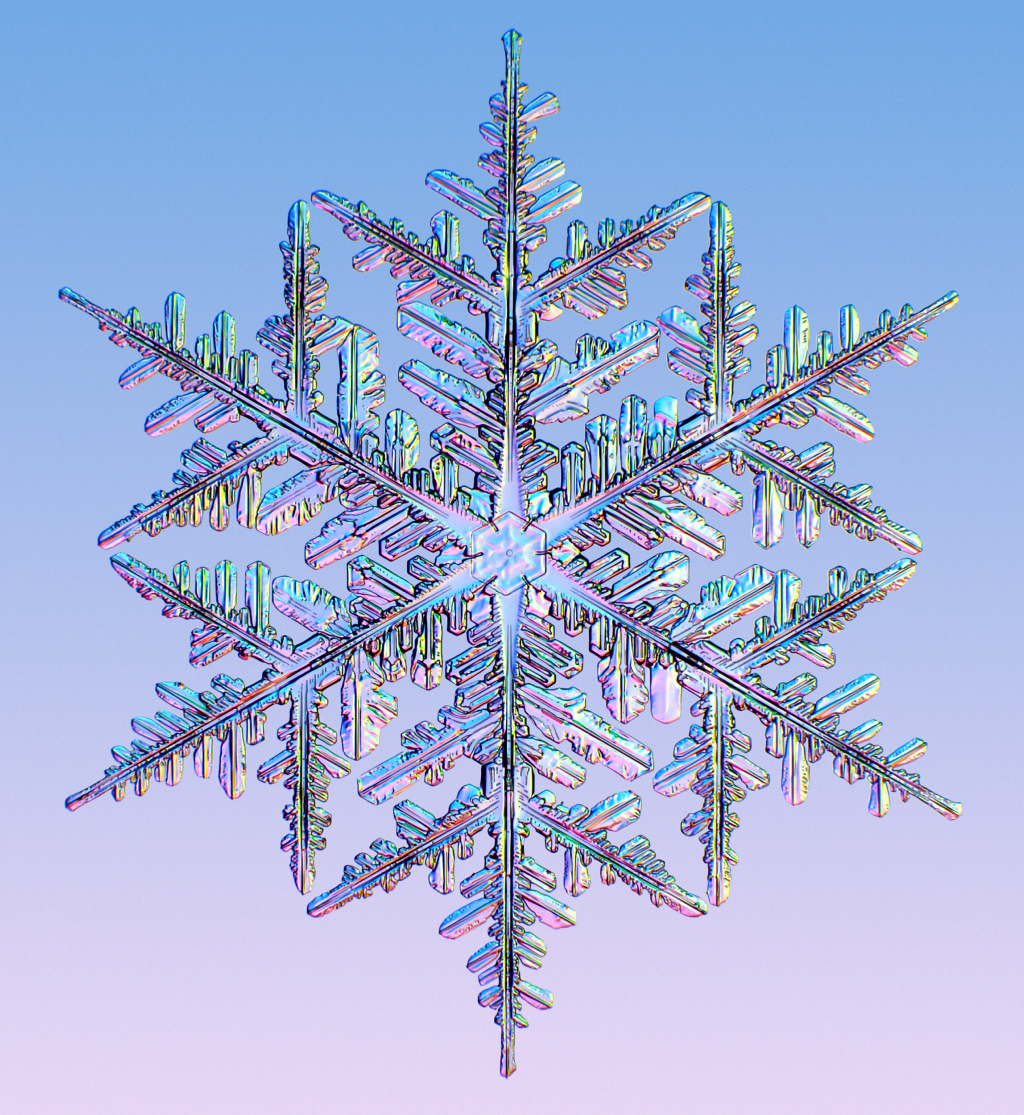
Snowfall the next 3 days:
Forecast Hour: 072
Image URL: http://mag.ncep.noaa.gov/data/nam/12/nam_namer_072_snodpth_chng.gif
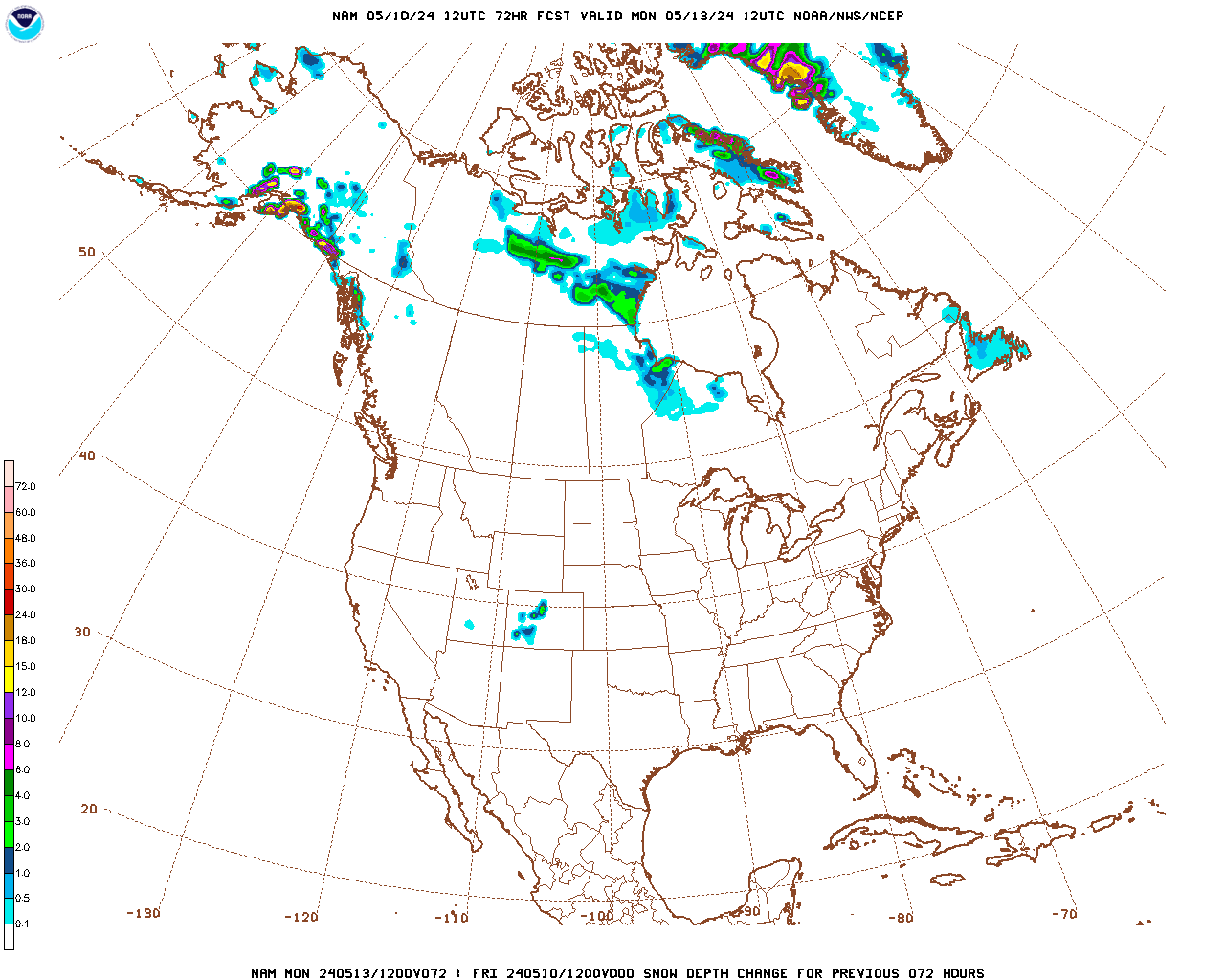
| Low Temperatures Tomorrow Morning |

Highs for days 3-7:
On the chilly side for this time of year.
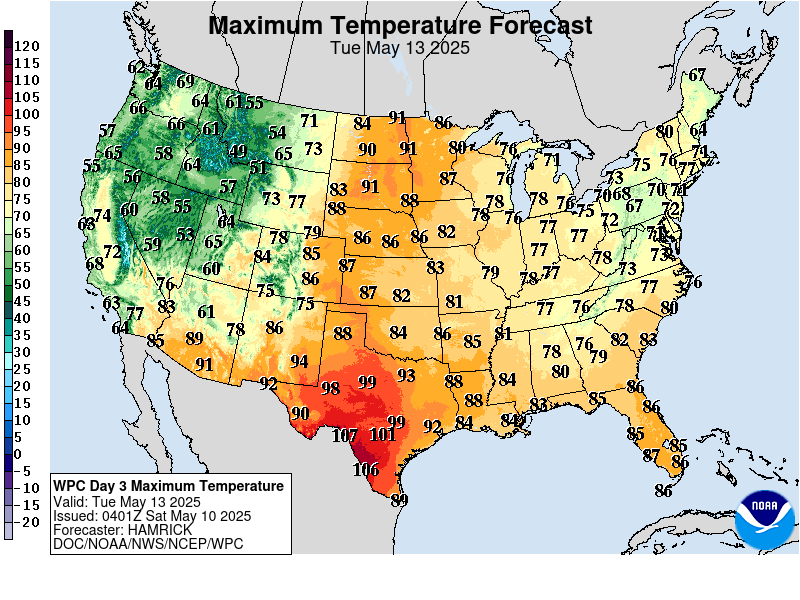
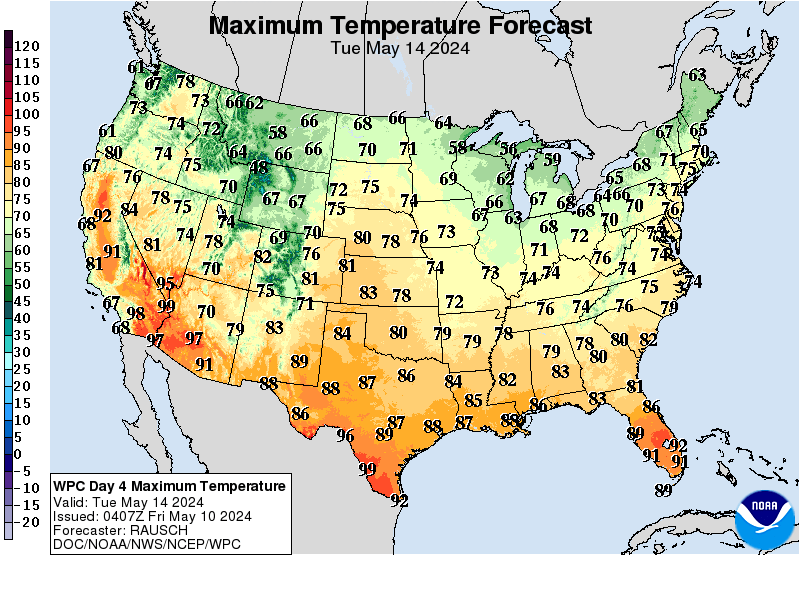
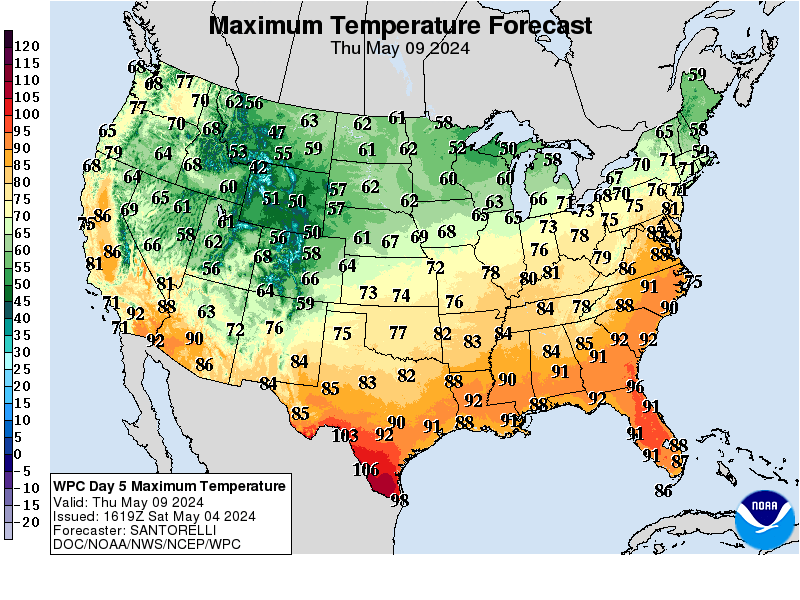
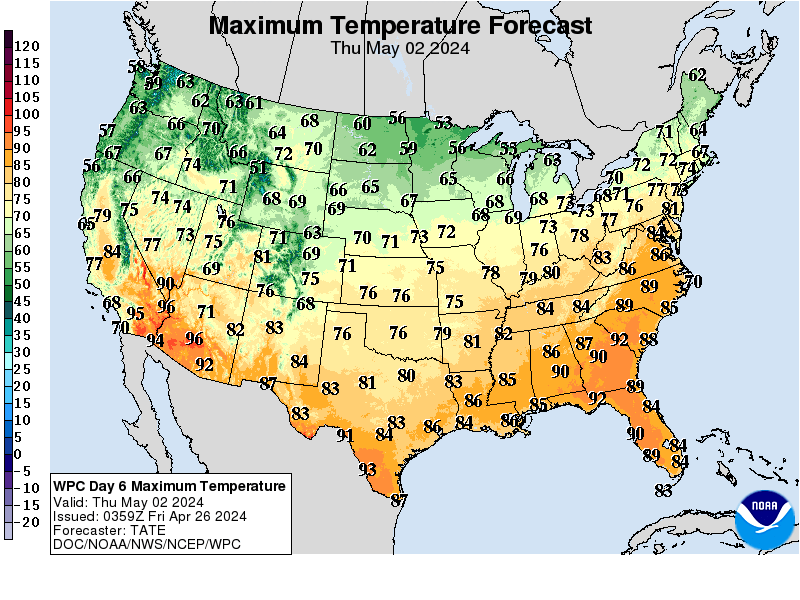
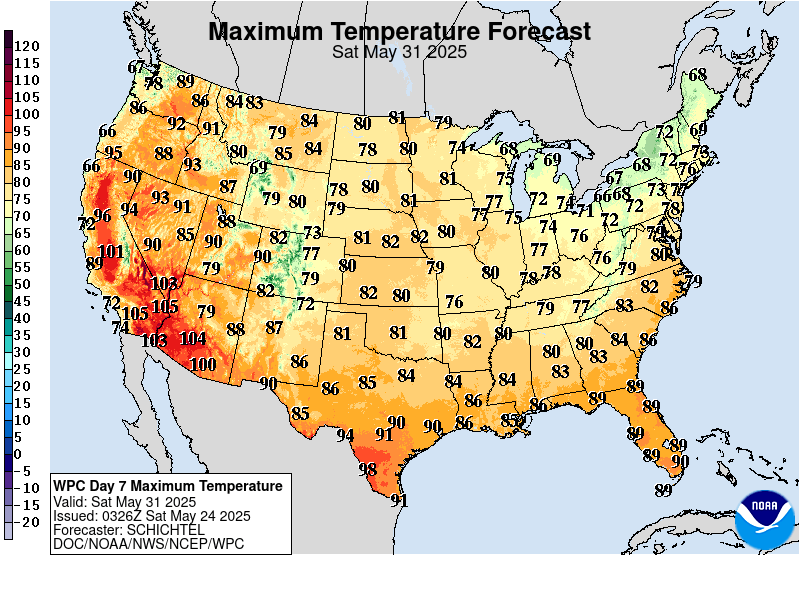
How do these days 3-7 temperatures compare to average at this time of year?
A bit below average and cooler than Monday, especially Northeast.
https://www.wpc.ncep.noaa.gov/medr/medr_mean.shtml
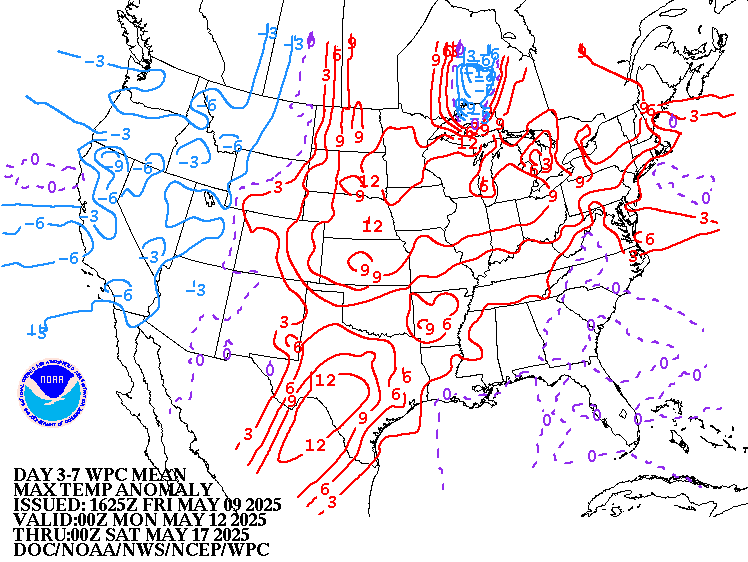
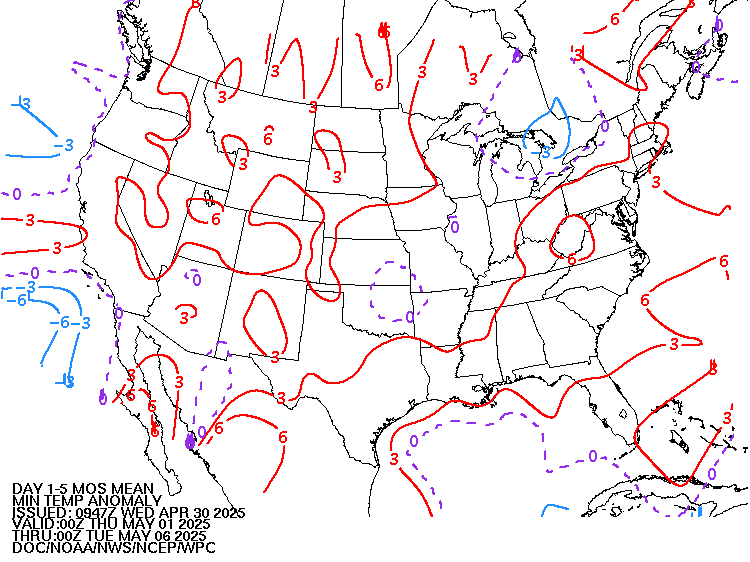
Weather maps for days 3-7 below
Monday: Tranquil......mild Pacific origin High pressure and a couple of weak cold fronts. Than turning wet/active at the end of this period.
Tuesday: Some northern stream cold is injected into the cold fronts and have dropped the temperatures for this forecast period in the last 24 hours............by quite a bit in some places. Looks especially wet in the S.Plains and points east to northeast in the late parts of this period.
Wednesday: Same trends as Tuesday. Very chilly Northeast from the northern stream. Very wet southern half from the southern stream. 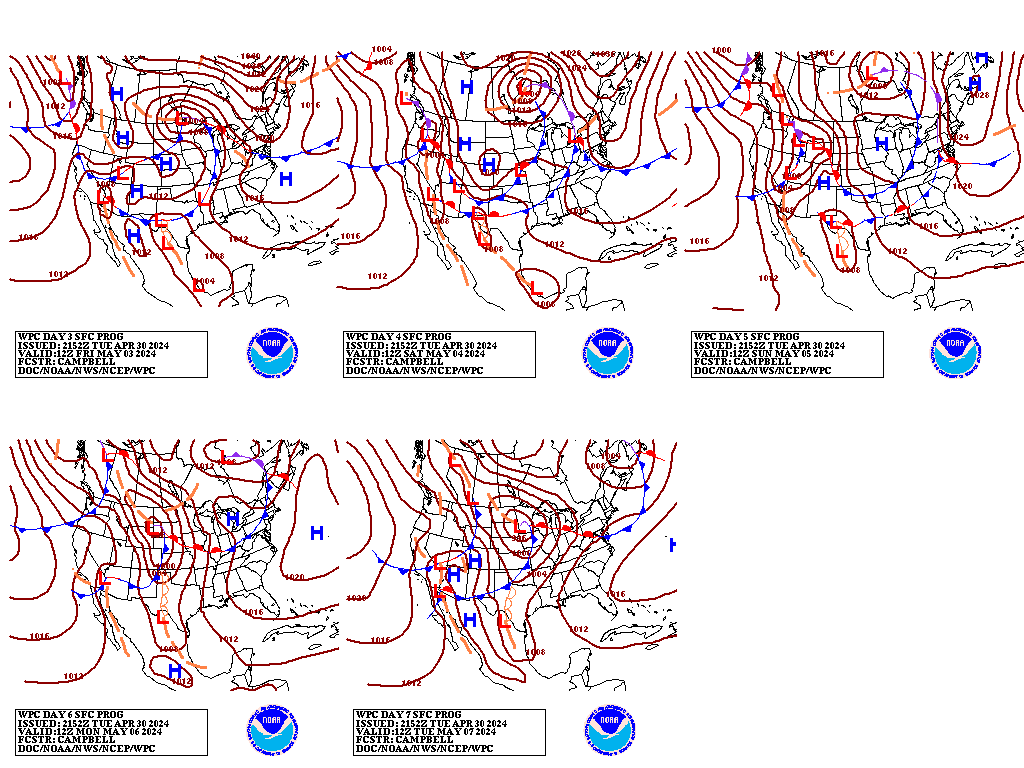
Liquid equivalent precip forecasts for the next 7 days are below.
Southern half/60% to East Coast turns very wet in a few days.
Day 1 below:
http://www.wpc.ncep.noaa.gov/qpf/fill_94qwbg.gif?1526306199054
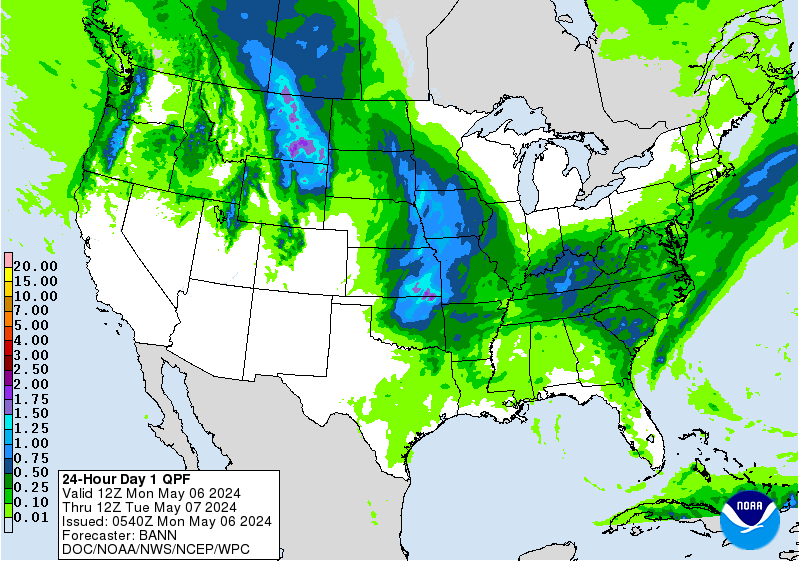
Day 2 below:
http://www.wpc.ncep.noaa.gov/qpf/fill_98qwbg.gif?1528293750112
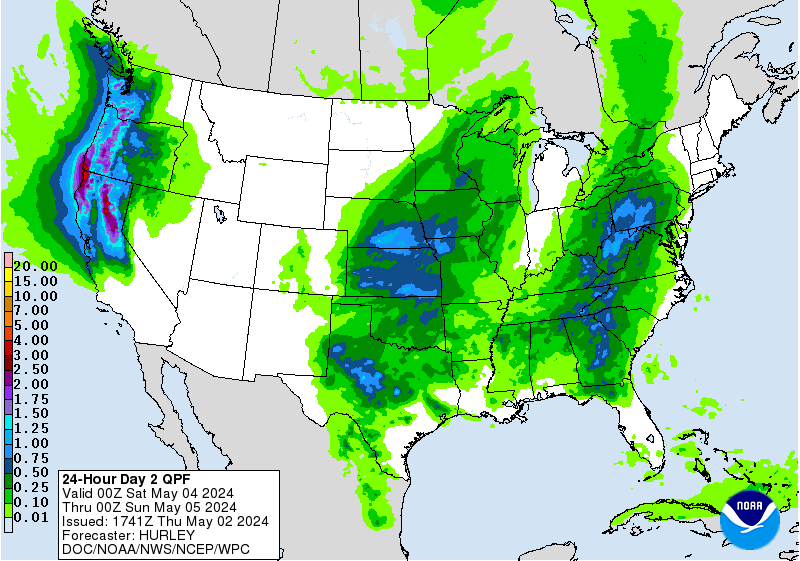
Day 3 below
http://www.wpc.ncep.noaa.gov/qpf/fill_99qwbg.gif?1528293842764
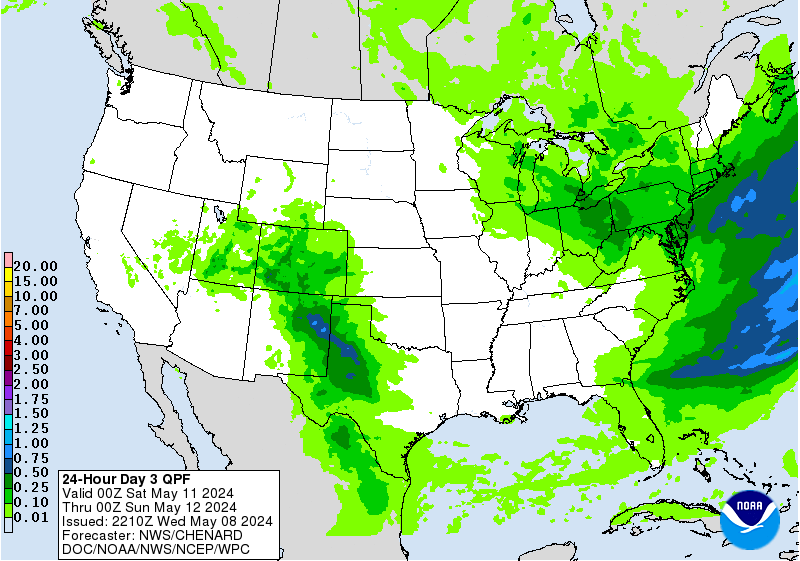
Days 4-5 below:
http://www.wpc.ncep.noaa.gov/qpf/95ep48iwbg_fill.gif?1526306162
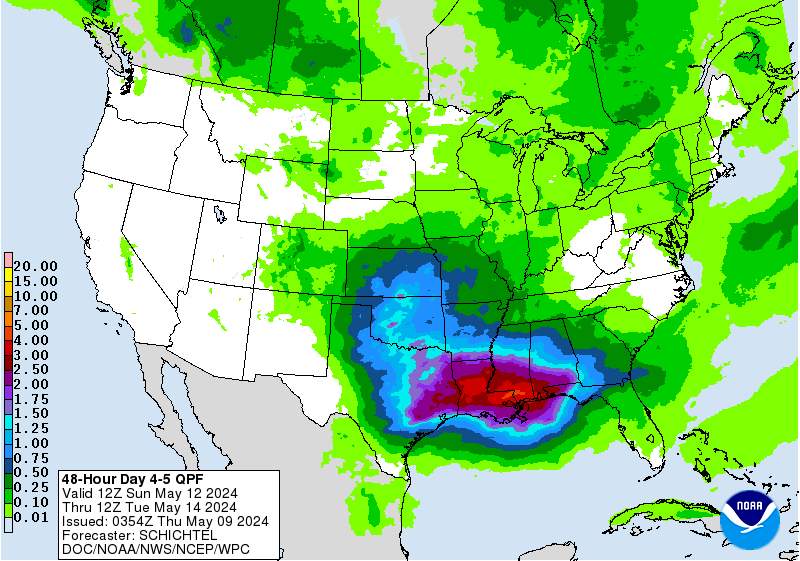
Days 6-7 below:
http://www.wpc.ncep.noaa.gov/qpf/97ep48iwbg_fill.gif?1526306162
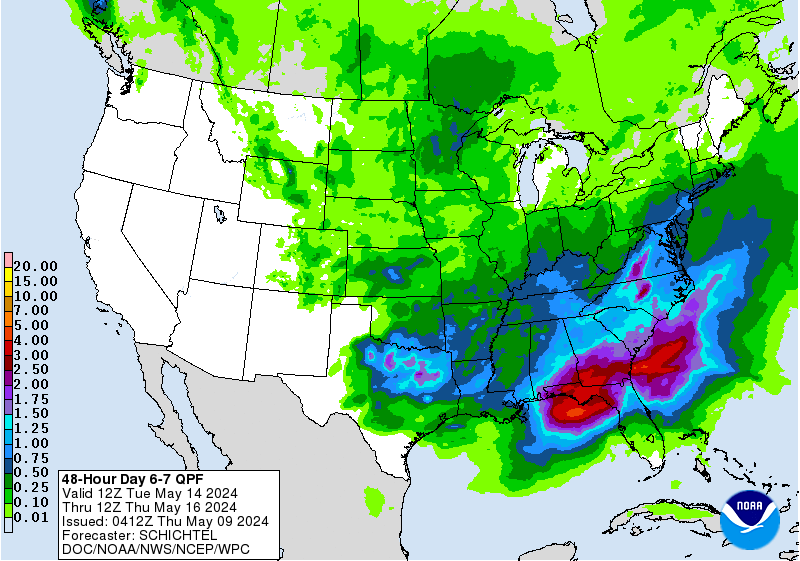
7 Day Total precipitation below:
http://www.wpc.ncep.noaa.govcdx /qpf/p168i.gif?1530796126
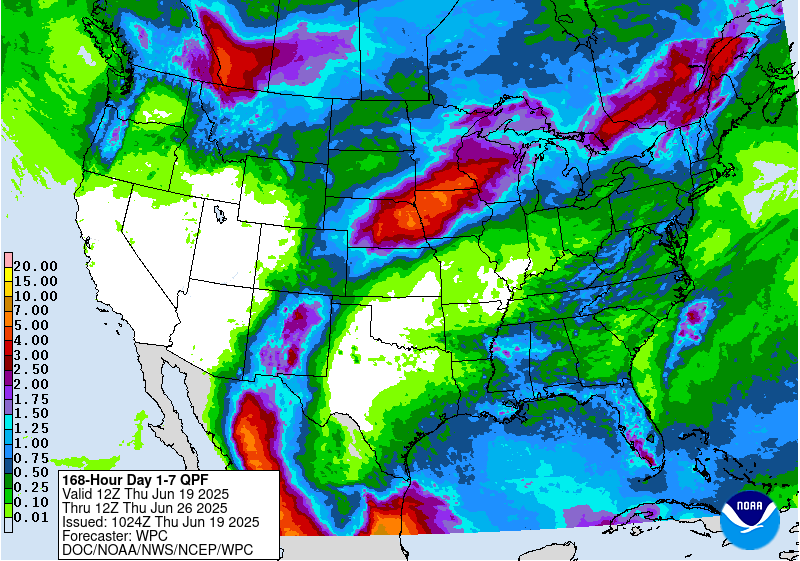
Current Dew Points
A bit of moisture collecting in the center with a weak system.

Latest radar loop
http://www.nws.noaa.gov/radar_tab.php

| Full resolution version loop (3400x1700 pixels - 2.2mb) |

Go to: Most Recent Image
You can go to this link to see precipitation totals from recent time periods:
https://water.weather.gov/precip/
Go to precipitation, then scroll down to pick a time frame. Hit states to get the borders to see locations better. Under products, you can hit "observed" or "Percent of normal"
+++++++++++++++++++++++++++++++++++++++++++++++
+++++++++++++++++++++++++++++++++++++
Precipitation compared to average for the last 7, 14, 30 and 60 days.
Usually not updated for previous day until late the next day.
https://www.atmos.illinois.edu/~snodgrss/Ag_Wx.html




https://www.marketforum.com/forum/topic/25818/
Currently, there is 0% of the Cornbelt/Midwest with drought. There is no place even slightly dry there or east of the Rockies, other than in TX and coastal SC/GA.
I am pretty sure that this has never happened since records have been kept. We will be watching for a potential increase in substantial rains again during the last week of March.
https://droughtmonitor.unl.edu/

The top map is the Canadian ensemble average, the maps below are the individual members that make up the average
+++++++++++++++++++++++++++++++++++++++++
Each member is like the parent, Canadian model operational model.......with a slight tweek/variation in parameters. Since we know the equations to represent the physics of the atmosphere in the models are not perfect, its useful to vary some of the equations that are uncertain(can make a difference) to see if it effects the outcome and how.
The average of all these variations(ensembles) often yields a better tool for forecasting. It's always more consistent. The individual operational model, like each individual ensemble member can vary greatly from run to run.........and represent an extreme end of the spectrum at times. The ensemble average of all the members, because it averages the extremes.............from opposite ends of the spectrum.........changes much less from run to run.
End of week 2....................0z ensembles from WEDNESDAY:
Analysis starting from a week ago, ending with today:
Last week+ of analysis, starting with the day farthest in the past:
Wednesday: The much milder, new pattern featuring mild Pacific flow that spreads from west to east across the country keeps looking impressive.
Thursday: No changes........very mild using updated 12z model run.
Friday: Still very mild but the southern stream(El Nino?) looks like its going to become more active and turn wet again after a week+ of dry weather. Upper level trough seen from the Southwest to S.Plains area.
Saturday: Less uniform solutions with more uncertainty with regards to temperatures and precip. Most solutions have a very amplified upper level low/trough, mostly from southern stream origins with the tropical Pacific/El Nino in a state to provide contributions. However, the northern stream and flow pattern in Canada is a bit more favorable to deliver some cold into that system.
Sunday: The southern stream looks VERY amplified this morning. Deep upper level trough in the Southwest in the mean with the individual solutions having varying versions of cut off lows that track in the flow coming out of the tropical Pacific. Lots of energy and moisture with tropical Pacific/El Nino origins. Not much opportunity for widespread northern stream cold to get pulled in..........especially in the East.
Monday: Not much change from Sunday. The noted feature is the southern stream trough from the Southwest to S.Plains and its potential to cause wet weather to the east.
Tuesday: A few members trying to invigorate the northern stream which shows up in the mean as sort of a northwest flow in Canada but still not deep enough south to be dominant in the US............where the southern stream will rule. The modest northern stream cold that invades is actually around a week before this late week 2 period.
Wednesday: Very active. Many different solutions. Southern stream dominates but northern stream feeding cold into N/C Canada is looking much more impressive today. Will any of that cold make it into the US??
360h GZ 500 forecast valid on Apr 04, 2019 00 UTC
0Z GFS Ensembles at 2 weeks:
Analysis, starting with a week ago:
Last Wednesday: Still very mild but with a couple of outliers that want to over amplify a northern stream low/trough and drive it into Southeast Canada from the ridge/west, trough/east couplet in the higher latitudes.
Thursday: Very mild. Pretty uniform agreement.
Friday: Similar to yesterday. Not quite as wet as the Canadian model but wetter than yesterday and turning wetter after the dry period leading up to this. El Nino southern stream could get pretty active.........aimed at S.Plains.
Saturday: Deep upper level trough on all solutions. Ridging in Canada and down stream troughing could provide the set up for some higher latitude cold to drop south.
Sunday: The ridge west/trough east couplet in Canada is gone today..........so chances to turn cold again have plunged from yesterday. Active southern stream will be steal the show. Very active.
Monday: Still high potential for an active southern stream.
Tuesday: A few now with northern stream action, especially prior to these late week 2 maps. Southern stream still much more active.
Wednesday: Very wet and active southern stream. Very cold air pooling in Canada., north of the US.

Ensemble mean(average of all the individual solutions above)
Last Wednesday: The big upper level ridge in Western North America builds all the way north........to Siberia but the downstream trough is waaaay to far north for any northern stream derived dynamics to get as far south as the US. This may just represent a seasonal migration northward of the jet stream and position of the main weather features. Mild Pacific flow dominates here.
Thursday: Ridge west also extends farther east with positive upper level height anomalies into the Plains and eastward. Very mild Pacific air spreads across the country.
Friday: Similar to Thursday.
Saturday: The upper level ridge anomaly centered by Alaska will have to be watched to see if enough northern stream energy digs southeast to couple with any troughing much farther east.
Sunday: The upper level ridge anomaly by Alaska has greatly shifted, to a ridge axis that extends southeast across all of Canada to the Northeast US. No chance for northern stream cold to work into the East under that set up. Negative anomolies setting up from the Pacific, aimed towards the S.Plains associated with what will be an active southern stream.
Monday: Upper level anomolies have shifted the past 2 days from ridge/west, trough east to trough/west, ridge east. The means warmer in the East, colder in the West but not northern stream cold. It's also the signature for the potential for widespread precip, depending on where the departures line up.........warm/moist air transported north from the Gulf of Mexico and Pacific energy from the trough aimed towards that moisture.
Tuesday: At this period, the mean shows little threat for very cold air from the northern stream. A new big anomaly center it up in Siberia but without a connection south/southeast(troughing) downstream to feed that cold across Canada into the US. The anomalies in the US, favor wet weather.........like yesterday.
Wednesday: The Siberian High connects to lower heights downstream in N. Canada where cold air will collect......down to central Canada. A positive anomaly in the Northeast will make it tough for the cold to penetrate into the US..........but things are changing fast on updates.
Latest, updated graph/forecast for AO and NAO here, including an explanation of how to interpret them.
Previous analysis, with the latest day at the bottom for late week 2 period.
Last Tuesday: Indices today are becoming volatile at the end of week 2. AO positive but drops to near zero at the end of 2 weeks. NAO also falling but still a bit positive. The wide spread means a bit more uncertainty and a slight increase that cold could return at the end of March(but still unlikely). PNA positive but falling. It's getting too late in the heating season for cold to make a big difference.
Wednesday: Positive AO and NAO make cold air intrusions unlikely. Positive PNA means ridging and warmth in the West.
Thursday: Positive AO and NAO still make very cold air intrusions unlikely. Positive PNA because of the ridge in the West..........which expands eastward.
Friday: Positive AO and NAO. Positive PNA is dropping fast late in week 2 as the upper level ridge in the Soutwest breaks down from an El Nino induced Pacific stream? Mainly to the south.
Saturday: Some noteworthy changes today for the first time in a long while. Both the AO and NAO are not as positive and drop fast towards the end of week 2, with several members actually in negative territory then. Unlike previous days that made very cold air intrusions very unlikely with the indices at those values, today, the door is open for that POSSIBILITY...........just need to be watched. PNA stays positive, a sign of the upper level ridging in the Northwest US to all of W. Canada. Upper level troughing and Tropical Pacific moisture/energy will be a factor farther south.
Sunday: Huge change back to positive AO and NAO, making major cold intrusions unlikely in the East in early April.
Monday: All the indices are positive and suggest the northern stream will not be a major factor. Weather models are pointing to an active southern stream from late March into April.
Tuesday: The AO and NAO are not nearly as positive as yesterday and just barely above zero at times............a bit more favorable for cold, especially prior to this period. The PNA stays a bit positive.........ridging in northern North America.
Wednesday: Volatility in the indices and a fairly wide spread..........so there is uncertainty. AO drops, now a few are negative at 2 weeks, so there is a decent chance of cold at the highest latitudes moving south at this time(how far south? is the question) NAO also falls then but still just above zero, so cold may be more favorable to the west. PNA is slightly positive.
The link below, now has the PNA index added at the bottom:
National Weather Service 6-10 day, 8-14 day outlooks.
This period will be noted by widespread precip from the southern stream!!! There will not be much early planting in the US this year as this period extends into early April.
Temperature Probability | |
Precipitation Probability | |
| the 8-14 day outlooks ArchivesAnalogsLines-Only FormatGIS Data | |
Temperature Probability | |
 | |